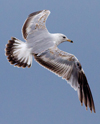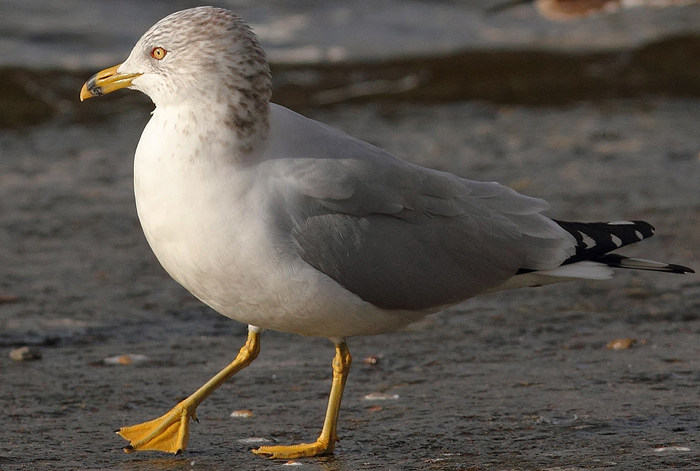|
||||||||||||||||||||||||||||||||||||||||||||||||||||||||||||||||||||||||||||||||||||||||||||||||||
Coordinators: 1cy June 2cy Jan 3cy Jan adult Jan |
1st > 2nd cycle (2CY): JuneRing-billed Gull - Larus delawarensis. Description in "Gulls of North America, Europe, and Asia", by Klaus Malling Olsen & Hans Larsson, Princeton University Press. This is a copy of the chapter on Ring-billed Gull, written by Klaus Malling Olsen. "I" in the text refer to the author. If you find any errors, please let me know at marsmuusse at gmail dot com. Ring-billed Gull - Larus delawarensispart 1: IDENTIFICATION of ADULT below part 6: GEOGRAPHICAL VARIATION, DISTRIBUTION & MEASUREMENTS GEOGRAPHICAL VARIATION
DISTRIBUTION AND MIGRATION Leaves breeding colonies mid July-early Aug, staying at Lake Erie and other lakes before further migration. Winter quarters reached from Sep. Migrates along rivers in interior USA to winter quarters in S USA, Great Lakes and St Lawrence River to coastal New Brunswick. Gatherings >200,000 Cleveland, 300,000 Lake Erie and tens of thousands in Appalachian region and Great Lakes, Oct-Dec, before freeze-up, eventually migrating over wide front to E coast, heading for Chesapeake Bay. In mild winters many stay e.g. 30,000 Pennsylvania, 20,000 Illinois/ Kentucky, >10,000 Ontario and >6,000 Appalachian Mountains. >10,000 winter in Florida with peaks every 5-6(10) years; >50% of winter population here from Great Lake regions. Also coasts and estuaries S to SE California, Greater Antilles and Mexico, where thousands winter (e.g. c.50,000 at night roost Salton Sea, Feb 2000). Main winter range for E population is N American Atlantic coastline between N Carolina and Florida. Max. 500,000 Cape Hatteras, N Carolina, late Dec/Jan, and max. 20,000 Virginia. W populations winter along the Pacific coastline S to Mexico and C America. Spring migration occurs in late Feb-Apr, birds heading more directly towards breeding sites. Peak in New Jersey is in late Mar with max. day-counts of 5,000 at Cape May. Flocks of max. 20,000 in California. Casual in summer in Caribbean and in winter in Alaska; regular Hawaii (Southern 1974a & b, Nisbet 1978, Cramp & Simmons 1983, Hoogendoorn & Steinhaus 1990, Sibley 1993, pers. obs.). Increasing winter visitor to W Europe; first recorded Azores 1945, Spain 1951 and Great Britain 1973. Now regular Great Britain (most numerous Nearctic vagrant gull); influxes of first-years 1980/ 81, 1984/ 85 and 1986/87; often followed by left-overs: 65% first-years 1981, 44% second-years 1982, 66% adults 1983. Annual average for Great Britain between 1958-1997 was 29, best year 1992 (103, mainly in SW). Most records are in mid-winter and spring; peak Mar-Apr, probably caused by birds heading N following wintering in areas further to S. Most summer records are second-years. Winter gatherings of max. 10 in W Ireland. Regular wintering France (max. 17 Jan-Mar 1999 and 25 Feb 2001), Iberian Peninsula (max. 18 Spain 1995/ 96; flocks of 10-15 on the Galician coast in the late 1990s), Azores (max. 50 1980 and flock of 56 Feb 2001); probably Morocco, Madeira and Canary Islands. Rare but regular Iceland (mainly spring-summer; 58 up to 2000) and Norway (29 up to 2000); indicates small migration route heading W from NE N America; summer occurrence probably a result of N migration following wintering E Atlantic. Germany 6, Belgium 11, Netherlands 7, Denmark 1, Sweden 12, Faeroe Islands 2, Poland 5. Furthermore vagrant to C and S Europe S to Italy, Albania and Bulgaria. Also Greenland 2, Senegal 1, S America 3, Galapagos 1 (Lack 1986, Small 1987, Hoogendoorn & Steinhaus 1990, Baillon & Dubois 1992, Poelmans 1992, BLIKI 1994, Boertmann 1994, Sorensen & Jensen 1994, Frainsson & Péturson 1997, Mitchell & Young 1997, Van den Berg & Bosman 1999, Fraser et al. 1999a & b, M. Elliott & A. T. Mjos in litt.). Increasing numbers of summering birds, often displaying to Common Gull (observed Great Britain, Netherlands and Sweden (in latter case 1993-99)) indicates that Ring-billed may establish itself as breeding bird in W Europe. There are several records of ringing recoveries of NE American birds in Europe. A bird ringed in Newfoundland spent several years in Norway and was eventually shot in Iceland (Mjos & Solheim 1995).
MEASUREMENTS
|
 Ring-billed Gull delawarensis 2nd PB moult (2CY), June 26 2011, Ballycastle, Ireland. Picture: Ian Dickey. Ring-billed Gull delawarensis 2nd PB moult (2CY), June 26 2011, Ballycastle, Ireland. Picture: Ian Dickey. |
||||||||||||||||||||||||||||||||||||||||||||||||||||||||||||||||||||||||||||||||||||||||||||||||
 Ring-billed Gull delawarensis 2nd PB moult (2CY), June 01 2013, Lake Michigan, Wisconsin. Picture: Terry. Ring-billed Gull delawarensis 2nd PB moult (2CY), June 01 2013, Lake Michigan, Wisconsin. Picture: Terry. |
||||||||||||||||||||||||||||||||||||||||||||||||||||||||||||||||||||||||||||||||||||||||||||||||||
 delawarensis Ring-billed Gull
delawarensis Ring-billed Gull
